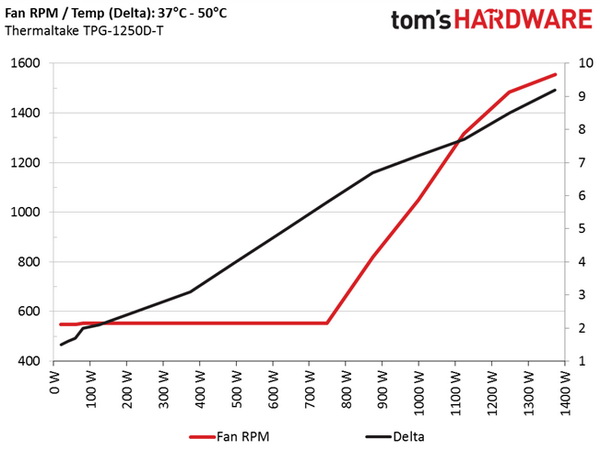Thermaltake Toughpower DPS G RGB 1250W PSU Review
Thermaltake recently released a new flagship Titanium-class PSU, the Toughpower DPS G RGB with 1250W max. power. Besides an RGB LED fan, this unit also features high performance, modular cabling, and compatibility with the SPM cloud platform.
Why you can trust Tom's Hardware
Efficiency, Temperature And Noise
Efficiency
Our efficiency testing procedure is detailed here.
Using the results from the previous page, we plotted a chart showing the TPG-1250D-T's efficiency at low loads, and loads from 10 to 110 percent of the PSU's maximum-rated capacity.




The Titanium-class Toughpower unit fares well against other offerings rated for similar efficiency. However, there's a pretty large difference between 115V and 230V input. In the graph above, notice that as the load gets higher the efficiency gap increases. This is natural since more load means increased amperage, and with 115V input, the primary side's amperage is doubled compared with 230V.
Efficiency At Low Loads
In the following tests, we measure the efficiency of the TPG-1250D-T at loads significantly lower than 10 percent of its maximum capacity (the lowest load the 80 PLUS standard measures). The loads we dialed were 20, 40, 60 and 80W. This is important for representing when a PC is idle, with power-saving features turned on.
| Test # | 12V | 5V | 3.3V | 5VSB | DC/AC Watts | Efficiency | Fan Speed | Fan Noise | PF/ACVolts |
|---|---|---|---|---|---|---|---|---|---|
| 1 | 1.208A | 0.491A | 0.485A | 0.195A | 19.63 | 69.73% | 548 RPM | 22.5 dB(A) | 0.831 |
| 12.046V | 5.067V | 3.298V | 5.062V | 28.15 | 115.2V | ||||
| 2 | 2.446A | 0.980A | 0.999A | 0.395A | 39.71 | 81.14% | 548 RPM | 22.5 dB(A) | 0.907 |
| 12.042V | 5.066V | 3.298V | 5.059V | 48.94 | 115.2V | ||||
| 3 | 3.686A | 1.476A | 1.515A | 5.055A | 59.82 | 85.92% | 548 RPM | 22.5 dB(A) | 0.957 |
| 12.036V | 5.065V | 3.299V | 5.055V | 69.62 | 115.2V | ||||
| 4 | 4.915A | 1.975A | 1.999A | 0.790A | 79.72 | 88.38% | 552 RPM | 22.5 dB(A) | 0.970 |
| 12.031V | 5.065V | 3.299V | 5.052V | 90.20 | 115.2V |
Under light loads efficiency is pretty high, especially if we take into account this PSU's huge capacity.
DPSApp Screenshots
You'll find screenshots of the DPSApp software below, which we took during under light loads.
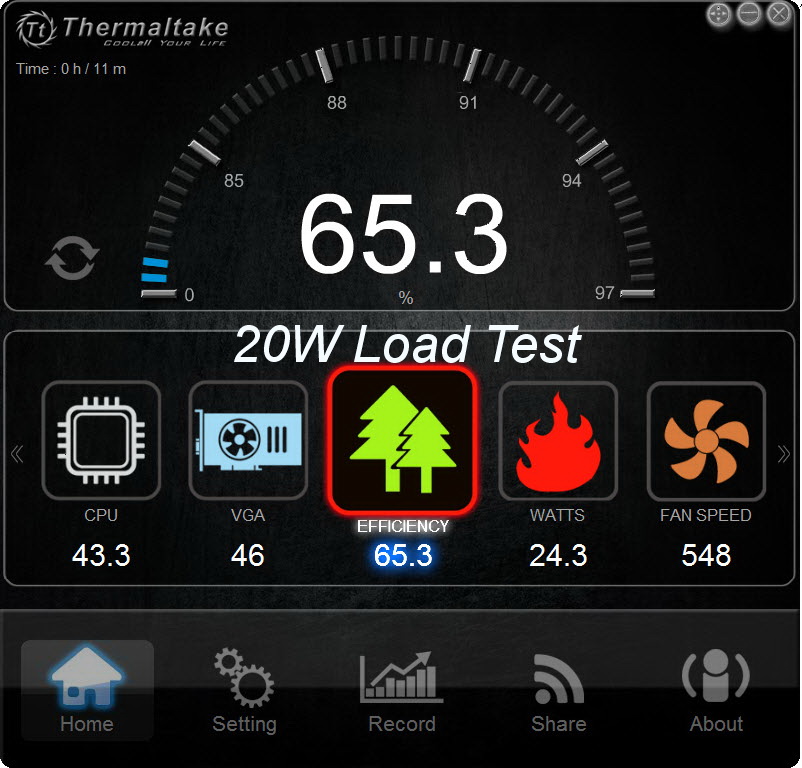
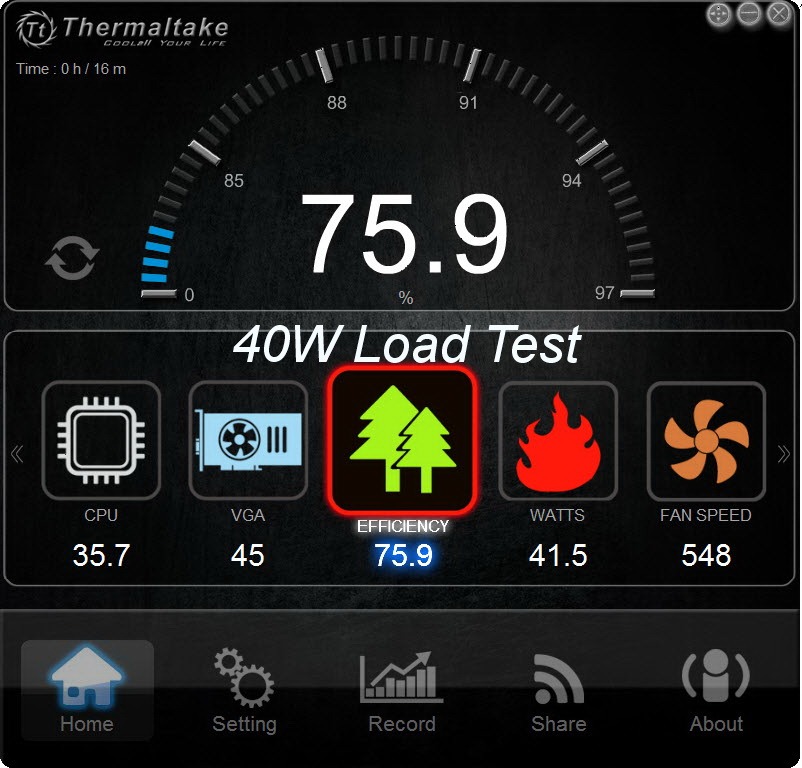
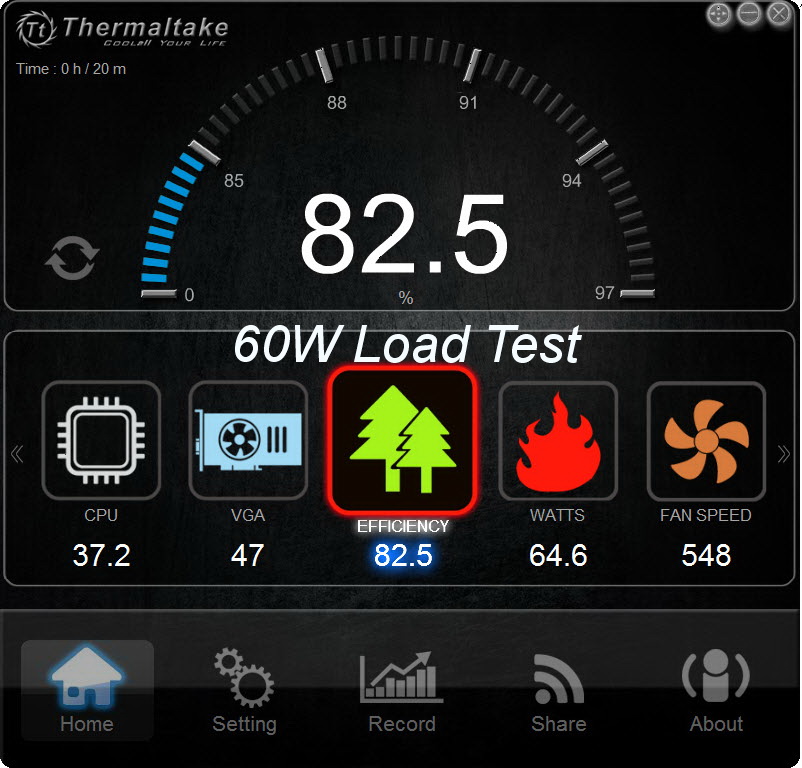

Under light loads the efficiency readings aren't accurate enough.
Get Tom's Hardware's best news and in-depth reviews, straight to your inbox.
5VSB Efficiency
The ATX specification states that 5VSB standby supply efficiency should be as high as possible, recommending 50 percent or higher with 100mA of load, 60 percent or higher with 250mA of load and 70 percent or higher with 1A or more of load.
We take four measurements: one each at 100, 250 and 1000mA, and one with the full load the 5VSB rail can handle.
| Test # | 5VSB | DC/AC Watts | Efficiency | PF/AC Volts |
|---|---|---|---|---|
| 1 | 0.101A | 0.50 | 74.63% | 0.066 |
| 4.989V | 0.67 | 115.2V | ||
| 2 | 0.251A | 1.25 | 81.70% | 0.142 |
| 4.987V | 1.53 | 115.2V | ||
| 3 | 1.001A | 4.98 | 82.86% | 0.354 |
| 4.973V | 6.01 | 115.2V | ||
| 4 | 3.001A | 14.82 | 80.85% | 0.495 |
| 4.939V | 18.33 | 115.2V |


The 5VSB rail is in line with the PSU's overall performance, meaning it's highly efficient. This is easily one of the most efficient 5VSB rails that we have encountered so far.
Power Consumption In Idle And Standby
In the table below, you'll find the power consumption and voltage values of all rails (except -12V) when the PSU is idle (powered on, but without any load on its rails), and the power consumption when the PSU is in standby mode (without any load, at 5VSB).
| Mode | 12V | 5V | 3.3V | 5VSB | Watts | PF/AC Volts |
|---|---|---|---|---|---|---|
| Idle | 12.046V | 5.071V | 3.301V | 5.070V | 7.58 | 0.466 |
| 115.2V | ||||||
| Standby | 0.05 | 0.005 | ||||
| 115.2V |

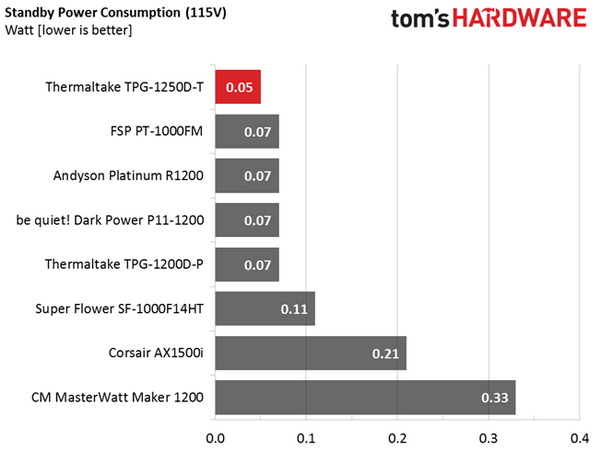
Vampire power is kept very low.
Fan RPM, Delta Temperature And Output Noise
Our mixed noise testing is described in detail here.
The first chart below illustrates the cooling fan's speed (in RPM), and the delta between input and output temperature. The results were obtained at 37°C (98.6°F) to 50°C (122°F) ambient temperature.
The next chart shows the cooling fan's speed (again, in RPM) and output noise. We measured acoustics from one meter away, inside a small, custom-made anechoic chamber with internals completely covered in sound-proofing material (be quiet! Noise Absorber kit). Background noise inside the chamber was below 17 dB(A) during testing, and the results were obtained with the PSU operating at 37°C (98.6°F) to 50°C (122°F) ambient temperature.
The following graphs illustrate the fan's output noise and speed over the PSU's operating range. The same conditions of the above graph apply to our measurements, though the ambient temperature was between at 28°C (82.4°F) to 30°C (86°F).
Under normal operating conditions, the PSU offers quiet operation. Up until around 700W of load, noise output is kept below 25 dB(A). Even under full load it stays within 40-43 dB(A) most of the time. It only exceeds 43 dB(A) briefly, as you can see in the graph above.
The PSU is equipped with a mid-speed fan that is combined with a highly relaxed profile. It needs a very efficient platform with low thermal loads to make such a combination viable.
Current page: Efficiency, Temperature And Noise
Prev Page Load Regulation, Hold-Up Time And Inrush Current Next Page Protection Features
Aris Mpitziopoulos is a contributing editor at Tom's Hardware, covering PSUs.
-
GPUEnthusiast I think those cables look straight ugly with three colors like that. In a windowed case, you won't even notice they're sleeved and it will instead look like an old style power supply with the rainbow wires, just really thick. I think they should stick with black and red, or just black. That yellow is faded too much and looks like it's for a banana themed build.Reply -
g-unit1111 Maybe it's me but I fail to grasp how an RGB ring on a PSU adds to it. Especially since most cases have bottom-mounted PSUs these days.Reply -
jimmysmitty Reply18420891 said:Maybe it's me but I fail to grasp how an RGB ring on a PSU adds to it. Especially since most cases have bottom-mounted PSUs these days.
It's all about them ground effects brah!!!!!
I agree though. Unless you have a very open bottom, most do not since most have a dust filter, it wont really show. I would expect a LED logo instead. -
turkey3_scratch This is a really great power supply! The transient response performance is top-notch. I really like it. The only thing I wish is for it to be a multirail design.Reply -
basroil Almost something I could recommend, if not for that horrible double line frequency oscillation in the 12V. I would have expected a digitally controlled system to be able to remove simple harmonics like that. Perhaps their controller algorithm isn't all that great?Reply -
powernod I was anxiously expecting this review due to CWT's new CST platform.Reply
Just like Aris said at the end of his review, i'm expecting to see how the smaller wattage models will perform.
The 1250 watt model seems like an excellent unit, and the only thing i disliked is the small output from the smaller rails ( 20A @5V &3.3V / 15A @5VSB ).
P.S. Once again, an excellent review from Aris!!
